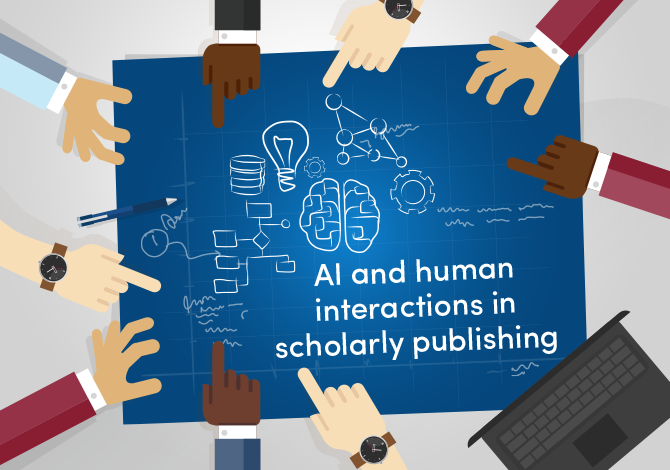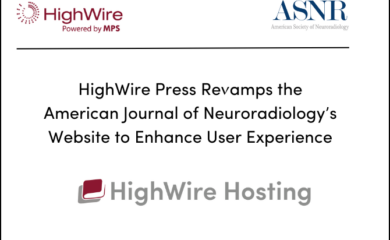From the discovery of new knowledge to its evaluation and dissemination, scholarly publishing is constantly evolving. This article will explore how AI can bring speed and efficiency to every area of scholarly publishing from content creation to evaluation, to enhancement and distribution of research papers.
Several organizations that work with scholarly content have already begun using AI to elevate the way they review and publish articles. For example, the National Natural Science Foundation of China is using AI-enabled automation to reduce bias and workload in their grant review process. Harvard, MIT and EdX are using an automated essay scoring system to assess the large volumes of written work that emerge as part of MOOCs. The American Association for Cancer Research uses AI to identify image duplication in manuscripts
Although AI and ML are used interchangeably and are related terms, AI refers to machines simulating human behavior and ML refers to machines being programmed to learn from existing data. This article will cover AI and some related ML aspects.
Artificial Intelligence and its role in scholarly publishing
Scholarly research output has increased dramatically over the past few years. For example, it is estimated that 4.7 million articles were published in 2020 alone. This deluge of research articles puts pressure on scholarly publishing workflows but can be channeled positively (after all, more research output means more scholarly resources) by using AI to enable speed and efficiency.
Here is how AI is disrupting six key spheres in scholarly publishing:
Decision-making
AI can be a great way to improve editorial decision systems in scholarly publishing. Like with any publication workflow, editors are a pillar in scholarly publishing. In addition to the average editor’s tasks of identifying important topics and novel research, editors who handle scholarly content often look for help from experts who can assist them in determining an article’s merits. AI is commonly used – across sectors and decision-making positions – to enable better decision-making because it is designed to extract actionable intelligence that can be used for making informed decisions. For example, a tool called Penelope.ai: can tell you right off the bat whether the references and structure of a manuscript meet the concerned journal’s norms and style. Meanwhile, another AI tool called Ripeta evaluates the integrity and reproducibility of scientific research. Sciscore helps scholarly publishers to evaluate transparency in submitted manuscripts and, it also works to help measure how easy it will be for other researchers to replicate a specific study and its results.
Content creation
The big news in the world of AI generated content is the meteoric rise on large language models, like ChatGPT and BERT that can create entire pieces of content on just a prompt. They are already being cited as co-authors on papers, though there is a lot of resistance to this. Scientists can accelerate time-to-submission by automating some areas of content creation. There’s already a handful of tools available for use. There are AI tools that can fast-track research. Other tools analyze research papers intelligently enough to output summaries. Still other tools let you find takers for your work. Alviss is an AI tool that automates abstract generation.
UNSILO recognizes key concepts in a research paper to create a summary. Audemic turns out audio summaries of research papers. Scite.ai puts all citations related to a specific research topic in one place to find related work. They also label works as supporting or contrasting – this means you know where to get ideas to support your research and you might even be able to predict how it may be questioned or contested.This type of tool can also be used to identify potential journals that might be interested in a specific resource. These tools use AI processes like text mining and Natural Language Processing (NLP).
Editorial review
AI is making strides in statistical and grammatical analysis as well as in analysis around taxonomy and ontology. This means that you can rely on the benefits of taxonomy and ontology when your content base needs them. A tool like StatCheck can be used to assess consistency in statistics reporting with a special focus on p-values.
Editors can also evaluate if researchers have covered all bases with Scite.ai (that we also talked about under content creation). Meanwhile, tools like Graphium and Sciflow help editors automate the creation of knowledge graphs and generally enable faster editing and proofreading of manuscripts at scale.
Peer review
AI can help remove several challenges in the peer review process. First and foremost, it might help in the search for peer reviewers. At present, although the volume of peer review invitations is growing at a pace of 10% per year, the volume of accepted invitations is growing at only 5% per year. Getting the correct fit between a reviewer’s interests and a specific manuscript could also help increase acceptance of review invitations and this too is made possible because AI can automatically assess manuscripts and identify ones that might be interesting to reviewers.
Searchability
Scholarly publishers can also benefit from metadata enrichments, metadata standardization, and search augmentations using NLP for semantic enrichment. This means adding topical metadata to content for machines to better understand it. It follows then that any improvements in metadata management could improve the searchability of scholarly articles online. It also helps make better content recommendations.
Minimizing retraction
Retraction of research papers can occur due to things that editors and reviewers might not be able to spot, like manipulated images or unsound statistics (or mistakes in statistical data representation). Approximately 20% of all published papers in life sciences have some form of image manipulation, also a major reason why many of these papers are retracted. However, with new AI-based image-checking tools like FigCheck, Proofig, ImaChek, Imagetwin, editors will be able to better spot manipulated images. AI is able to catch image duplication even when the images are manipulated by cropping, stretching, flipping, rotating and filtering them.
Where AI falls short in the scholarly publishing world
AI cannot yet replicate human intelligence in many areas. For example, it can make data around content more accessible and more useful, and might even be able to recommend manuscripts that fit a specific journal, but you still need an editor’s actual judgment. AI tools might point reviewers in the right direction whe, but they cannot replace the reviewer’s experienced oversight.
Moreover, as we discussed at the start of this article. AI simulates human behavior. But humans are prone to behaving with bias and it is humans who model data for AI and ML systems, and therefore you can expect that bias to creep into the algorithm too.
And then there’s the fact that a new AI can be built to outsmart the current watchdog AI. Enter tortured phrases. This refers to intentional rephrasing with the goal of getting past AI-based checks using AI. A tortured phrase might say colossal information instead of big data as the creator’s AI attempts to outsmart the watchdog AI. And yes, this is already happening. In April 2021, a group of computer scientists found fabricated research papers because of tortured phrases.
Conclusion
As the paragraph above depicts, human oversight, creativity, and decision-making remain critical in scholarly publishing. In the instance of fabricated research papers noted above, it was a group of humans, after all, who discovered the use of tortured phrasing. So although an AI may be used to catch plagiarism, what it misses (as other AI tools designed to outsmart it come along) can be caught through human intervention.
It would be incorrect – at least at this juncture – to think of AI as a replacement for human intelligence. There’s no eliminating human researchers, scientists, and creators although they can improve the quality of their research with AI. We called this article AI and human interaction in scholarly publishing to underscore that it is not about artificial intelligence replacing human intelligence, but rather augmenting and strengthening human intelligence.
The recording of HighWire’s best practices webinar series on ‘Practical Uses of Artificial Intelligence and Machine Learning in the Scholarly Publishing Process’ is available now. Watch here.



